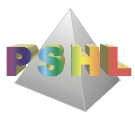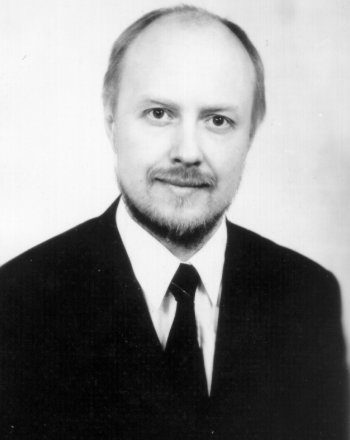
 |
|
|

Nikolai Nikolaevich Ledentsov was born in Leningrad, USSR on May, 3, 1959. In 1976 he finished the high school No 157 in Leningrad with extended education in physics and mathematics. In 1976 he entered the Electrical Engineering Institute in Leningrad (faculty of electronics). In 1982 he graduated from the Optolectronics Department of the Electrical Engineering Institute in Leningrad (educational depatment of Abraham Ioffe Institute, with honors). In 1982 he started his work as a scientific researcher at the A.F. Ioffe Phyisical Technical Institute in Leningrad (Candidate of Physical-Mathematical Sciences (PhD) - A. F. Ioffe Institute, 1987; Doctor of Physical-Mathematical Sciences - A.F.Ioffe Institute (1994)). In 1995 - 1999 he is a leading research scientist, head of the research group. In 1999 he is a distinguished scientist (top scientific grade) at Ioffe Institute. Prof. N. N. Ledentsov started his scientific activity at A. F. Ioffe Institute, at the laboratory of Prof. Zhores I. Alferov in 1979, when he was a third-year student. His main interests are related to MBE growth, thermodynamic analysis of MBE growth processes, optical characterization of quantum wells, quantum wires and quantum dots and devices based on these structures. He has got a reputation in the MBE community due to his contribution to the thermodynamic analysis of segregation effects in MBE (e.g. J. Cryst. Growth 104, 345-354 (1990); ibid. 108, 661-669 (1991), ibid. 111, 151-161 (1991); Mat. Sci. Forum 69, 9-12 (1991)). In 1988 he writes an invited review on Molecular Beam Epitaxy (Sov.Phys. Semicond. 22, 1093-1101 (1988)). Further rapid progress resulted in priority device results in the Soviet Union on realisation of MBE-grown low threshold current density GaAs-AlGaAs QW lasers, strained quantum well lasers, red-emitting and IR lasers, double-barrier resonant-tunnelling diodes, HEMT-transistors, etc. The world record in threshold current density for QW lasers has been established at 40-50 A/cm-2 at 300K [Pis'ma v Z.Tekn.Fiz. 14, 1803-1807 (1988) (Sov.Techn. Phys. Lett); Fizika i Tekn.Poluprovodn. 24, 152-158 (1990) (Sov.Phys. Semicond. 24, 92-95 (1990))]). Starting from 1990 he is mostly concentrated on self-organized growth and studies of optical and electrical properties of quantum dot and quantum wire structures. In 1990-1991 he was working as a guest scientists at the Max-Planck-Institut für estkörperforschung, Stuttgart. Here he contributes to the discovery of spontaneous periodic nanofaceting on various high-index surfaces [Phys.Rev.Lett. 67, 3812-3815(1991); Superlattices and Microstructures, 12, 317-320 (1992), Appl.Phys.Lett. 60, 1615-1617(1992); Phys.Rev. B 45, 3507-3515 (1992); Surf.Sci. 267, 209-213 (1992); Phys.Rev. B47, 1299-1304 (1993); JETP letters, 57, 120-124 (1993)] and to studies of optical properties of these structures. Optical anisotropy has been discovered for QW structures grown on (311) surface, giant mixing of G and X minima in type-II GaAs-AlAs (311) superlattices, LO-phonon-related exciton relaxation mechanism in these structures, etc. Starting from 1993 he became a coordinator of several projects devoted to self-organized growth of quantum dots in lattice-mismatched III-V and II-VI materials, including Stranski-Krastanow and Volmer-Weber island growth and submonolayer depositions. Together with his colleagues he reported first lasing (at low and at room temperature) in self-organized quantum dots (QDs) [Semiconductors 28, 832-834 (1994), submitted December 1993]. He also coauthored a paper on the first injection lasing in self-organized QDs [Electronics Letters 30, 1416 (1994)]. More recently first competitive edge emitting [Elecronics Letters 35, 1161 (1999)] and vertical cavity [Electronics Letters 33, 1150-1151 (1997)] QD lasers are created. Recently GaAs-based QD lasers operating at 1.3 Ám with parameters improved as compared to conventional quantum well devices on InP substrates, are created [Electronics Letters 35, 898 (1999); IEEE Photonics Technology Letters 11, 1345 (1999)]. First GaAs-based current injection vertical cavity surface-emitting lasers based on QDs emitting at 1.3 Ám are created (first reported by N.N.Ledentsov at the SANKEN symposium, Osaka 2000, published in Memoirs of the Institute of Scientific and Industrial Research, Osaka University, Vol. 57, 2000, pp.80-87). Recently CW operation of 1.3 Ám VCSEL is demonstrated. Recently long lifetime 1.3 Ám VCSEL CW operation with 1 mW output power and high wall-plug (10-15%) and differential (40%) efficiencies is demonstrated. Far infrared emission originating from intrasublevel transitions in QD lasers pointing to a possibility of a new type of FIR laser is observed. Photoluminescence from InAs QD in a silicon matrix is demonstrated. For the research in the area of quantum dots N.N. Ledentsov has got in 1996 Young Scientist Award of the International Symposium on Compound Semiconductors "For his pioneering and outstanding contributions to the development of physics and MBE growth of InGaAs-GaAs quantum dot structures and quantum dot lasers". For II-VI structures, using of submonolayer CdSe insertions allowed to lift the k-selection rule for exciton recombination via exciton localisation at CdSe nanoislands. As the QD excitonic lasing mechanism in II-VI quantum structures plays the dominant role, this localization allowed achieving a 0-phonon (resonant) gain in II-VI structures up to room temperature and above. This, in turn, allowed realization of a new type of a device - laser based on resonant waveguiding effect. Ultrahigh gain in lasers based on ultradense arrays of QDs permitted observation cavity-gain spectra interconnection (cavity self-adjustment effect) and allowed realization of wide gap room-temperature operated InGaN-GaN surface emitting lasers with moderate facet and Bragg mirror reflectivity. He authored and coauthored more than 300 publications (about 60 as a first author), including 25 papers in Physical Review B and Physical Review Letters. Coauthored 23 papers in Applied Physics Letters (5 as a first author), 9 in Electronics Letters. Starting from 1992 he is a Professor (Full Professor from 1994) at the Electrical Engineering University of St.Petersburg (Optoelectronics Chair). Prof. N. N. Ledentsov annually provides the course (obligatory): "Physics and technology of nanostructures" (B.Sc. Program) - 6 hours per week, the course (obligatory): "Application of nanostructures" for graduate (sixth year) students (M.Sc. Program) - 3 hours per week, and a course "Novel Trends in Optoelectronics" which consists of 8 hours per semester and is suited for a wide audience of students of the Electrical Engineering University interested in this subject. He is a scientific advisor of two Diploma and three PhD students. Prof. Ledentsov is a co-ordinator of several national and international research projects in the area of solid state physics and optoelectronics. His is a co-director of the NanOp project (Germany) from the Ioffe Institute side (see e.g. Physics Today, Dec. 98, p. 46). His research team is composed of six scientists holding a PhD degree (three researchers got PhD degrees under his supervision), three PhD students, two students and two technicians Professor Ledentsov is a Member of the Russian Academy of Sciences and acknowledged as one of the key Russian scientists in the fields of Solid State Physics and Optoelectronics. For a period 1999-2002 he was invited for a DAAD Guest Professorship at the Technical University of Berlin, Germany (Spring-Sumer semesters). Total number of coauthored invited talks at national and international conferences exceeds 40. Total number of papers exceeds 400. Prof. Ledentsov wrote a book Growth Processes and Surface Phase Equilibria in Molecular Beam Epitaxy, Springer, 1999, and coauthored a book Quantum Dot Hetersotructures (jointly with D. Bimberg and M. Grundmann) Wiley, 1999. He is currently preparing a new book with Springer on the theory of self-organized growth of nanostructures to be completed before January 2001 (jointly with V.A. Shchukin and D. Bimberg)
Prof. Ledentsov is awarded with
MembershipsPublication list of Prof. N.N. Ledentsov Contact information |